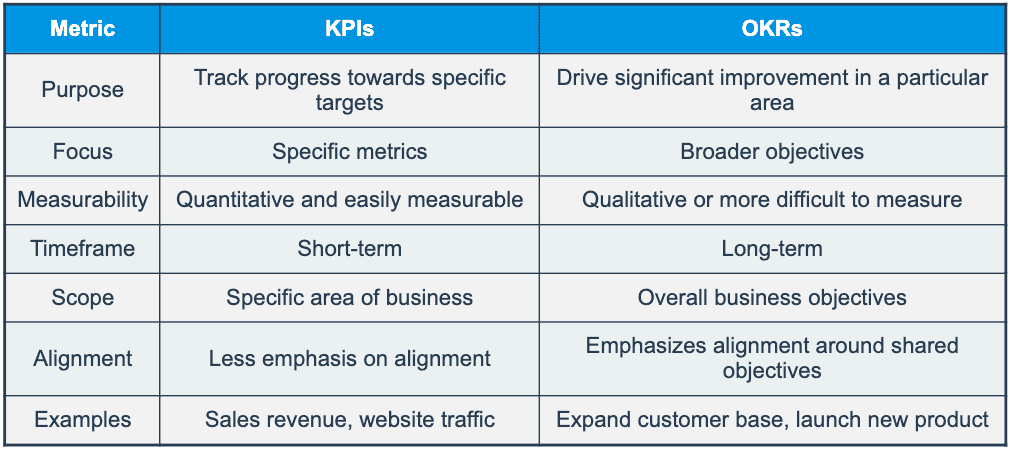As businesses strive to improve their performance, two terms have become increasingly common in recent years: Key Performance Indicators (KPIs) and Objectives and Key Results (OKRs). While both KPIs and OKRs are performance metrics, they differ in several important ways. In this article, we’ll explore the meaning and differences between KPIs and OKRs, and how to determine which is the best fit for your organization.
What are KPIs?
KPIs are metrics that track the performance of a specific area of a business. They are used to measure progress towards a goal or objective and to evaluate how effectively a business is achieving its targets. Examples of KPIs include revenue growth, customer satisfaction, employee turnover rate, and website traffic.
Management typically sets KPIs and uses them to monitor progress on a regular basis. They often tie KPIs to specific initiatives, such as a marketing campaign or a new product launch. KPIs are usually quantitative in nature, and objective data can measure them.
What are OKRs?
In contrast to KPIs, OKRs aim to assist a business in accomplishing its overall objectives by setting a collection of goals. OKRs have an aspirational and challenging nature, emphasizing driving significant improvement in a specific area. Senior leaders generally create OKRs and utilize them to align the organization around a common set of priorities.
OKRs consist of two parts: objectives and key results. Objectives are high-level, qualitative statements that describe what the business hopes to achieve. Key results, on the other hand, are specific, measurable outcomes that will help the business achieve its objectives.
OKRs flex and adapt by design, with stakeholders regularly reviewing and revising them based on business environment changes and feedback.
What are the differences between KPIs and OKRs?
While KPIs and OKRs are both important performance metrics, there are several key differences between them.

1. Focus
KPIs focus on tracking and measuring progress toward specific targets or goals, while OKRs focus on achieving aspirational and challenging objectives.
2. Scope
KPIs are typically narrow in scope, focusing on a specific area of the business, such as marketing or finance. OKRs, on the other hand, are broader in scope, focusing on overall business objectives.
3. Timeframe
Organizations often measure KPIs regularly, such as on a weekly, monthly, or quarterly basis. In contrast, organizations typically set OKRs for a longer timeframe, such as a year.
4. Alignment
Individual departments or teams typically set KPIs, while senior leaders set OKRs at a higher level. Senior leaders design OKRs to align the entire organization around a shared set of priorities.
5. Measurability
KPIs are usually quantitative in nature and can be measured using objective data. OKRs, on the other hand, may include qualitative objectives that are more difficult to measure.
Examples of KPIs and OKRs
To better understand the differences between KPIs and OKRs, let’s look at some examples.
Example 1: Marketing
KPI: Increase website traffic by 20% in the next quarter.
OKR: Increase brand awareness by becoming a thought leader in our industry. Key results include speaking at three industry conferences and publishing five guest blog posts in leading industry publications.
In this example, the KPI is focusing on a specific metric – website traffic – while the OKR is focusing on achieving a broader objective – becoming a thought leader in the industry.
Example 2: Sales
KPI: Increase sales revenue by 10% in the next quarter.
OKR: Expand our customer base by targeting new market segments. Key results include identifying and pursuing opportunities in three new markets and increasing the number of sales leads generated by 50%.
In this example, the KPI is focusing on a specific metric, which is sales revenue, while the OKR is focusing on a broader objective of expanding the customer base by targeting new market segments.
How to determine which is the best fit for your organization?
When deciding whether to use KPIs or OKRs, it’s important to consider the unique needs and goals of your organization. Here are some factors to consider:
- Alignment: If your organization needs to align around a shared set of objectives, OKRs may be a better fit. If you need to measure progress toward specific targets, KPIs may be more appropriate.
- Timeframe: If you need to track progress on a regular basis, such as weekly or monthly, KPIs may be more suitable. If you are looking to achieve long-term goals over the course of a year or more, OKRs may be more appropriate.
- Measurability: If your objectives are quantitative and easily measurable, KPIs may be more appropriate. If your objectives are qualitative or more difficult to measure, OKRs may be more suitable.
- Scope: If you focus on a specific area of the business, such as sales or marketing, you should use KPIs. On the other hand, if you focus on overall business objectives, you should use OKRs.
Conclusion
Businesses can use KPIs and OKRs to achieve their goals as both are crucial performance metrics. KPIs help track progress towards specific targets, while OKRs aim to drive significant improvement in a particular area. When selecting the appropriate metric for your business, it’s crucial to consider factors like alignment, timeframe, measurability, and scope. The key to success in a competitive market is to select metrics that align with your organization’s goals and help achieve them.


